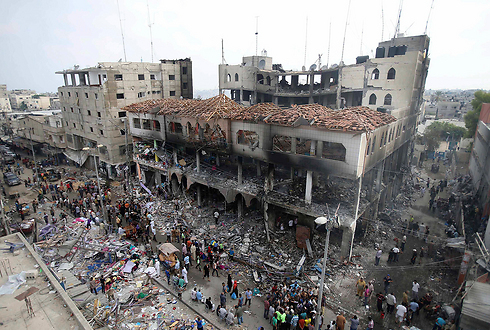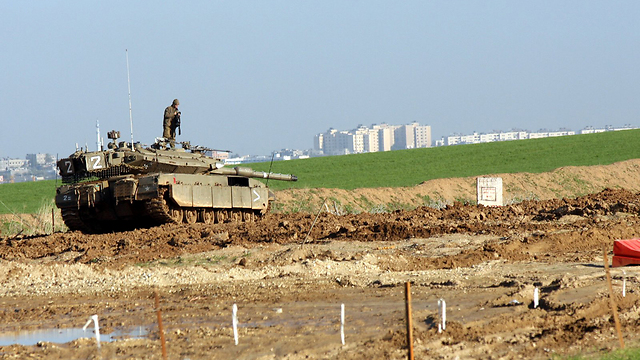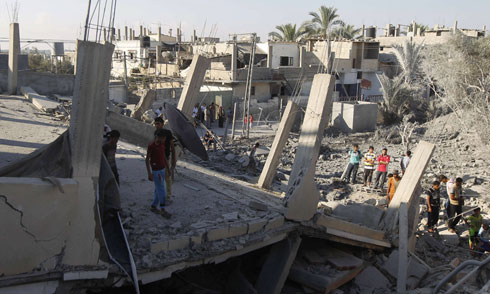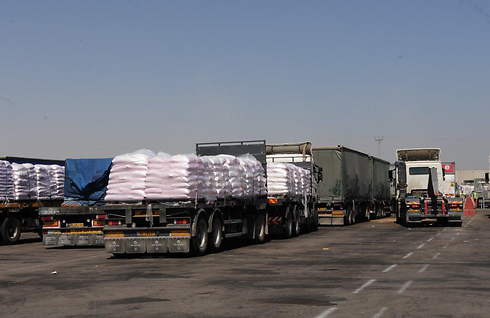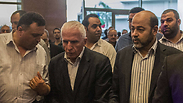
Easing Gaza restrictions is the new two-state solution
Analysis: Israel now admits that the almost-airtight blockade of Gaza has done more harm than good; on eve of Cairo truce talks, Israel shifts its focus to easing the lives of Palestinians in return for greater oversight over Hamas. This is how Israel hopes to restore calm to its south.
The current tensions between Prime Minister Benjamin Netanyahu and US President Barack Obama only conceal the deeper disagreement between Israel and the US and other Western allies, which has only grown in severity in wake of Operation Protective Edge.
Israel is committed to a two-state solution, our friends in Washington and the EU maintain; for them it is inconceivable that every couple of years Israel wreaks havoc in Gaza and they foot the bill for its rehabilitation.
Their conclusion: Peace talks with Palestinian President Abbas must be reignited, a move which will make it easier for them to recruit the Arab world to the fight against the Islamic State. Israel holds the opposite to be true, and therein lies a dramatic shift in policy.
For Jerusalem, in volatile times as these, there is no way to transfer the majority of the Jewish population in the Judea and Samaria to Palestinian sovereignty, even if it is demilitarized. It would be suicide, one high-ranking defense official said, and the heavy fighting during the Gaza conflict serves as testimony to what happens in areas from which Israel withdraws.
Regarding the option of renewed negotiations with Abbas – the assumption is that it will only end in a stalemate or an explosion of Palestinian anger. Moreover, Jerusalem doubts that moderate Arab nations need the resolution of the Palestinian issue to convince them to fight radical Islamists.
Therefore, instead of striving towards the two-state solution that would see the Palestinians receiving sovereign territory – which Hamas could then take over and use to fire rockets at mainland Israel - Jerusalem is shifting towards a "conflict management" approach, at least until the Middle East stabilizes and the current wave of radical Islamism passes.
Up until a few weeks ago, Israel managed its conflict with the Palestinians in Judea and Samaria independently from its Gaza policy, but now the two converge. Israel is even willing to pay a serious price for this to happen and thus – without much fanfare – Israel waived its objection to internal Palestinian reconciliation and the formation of the Palestinian unity government between the Palestinian Authority and Hamas. This government even convened for the first time in Gaza Thursday.
Israel is now trying not just to calm the Palestinian street in Judea and Samaria in order to prevent an uprising, but also, and with almost the same zeal, to prevent future conflict with Gaza, striving to extend the time periods between the almost inevitable renewal of fighting. Israel is not only trying to allow Abbas' PA to build institutions and regain control in the West Bank from the bottom up – but also allow him to extend his authority and control to the Strip.
On the ground, this means economic benefits and restriction easing for residents of the West Bank, and eventually for Gazans as well, including freedom of movement between the two Palestinian territories. Security considerations will be the only limitation, including the prevention of rearmament, and maintaining the IDF's power and ability to thwart terrorist attacks.
In addition, Israel will assist as much as possible with reconstruction efforts in the Gaza Strip and its economy, in an attempt to create an incentive for the population to demand that Hamas not drag it into another devastating war.
The security establishment now admits that Israel's airtight closure of the Gaza Strip has worked against the country's general interests. The blockade created common interests and solidarity between the economically troubled Hamas government and the suffering residents of Gaza, many of whom supported the armed struggle to harm the citizens of Israel, acting out of frustration and anger.
It is for this reason that before Operation Protective Edge had even begun, the IDF recommended that the cabinet adopt a policy aimed to dramatically improve the condition of the civilians of the Strip not involved in the fighting, with one limitation – preventing the rearmament of Hamas and Islamic Jihad.
The conflict management approach
Acting on the orders of the defense minister and prime minister, the security establishment did not wait for the end of the Cairo ceasefire talks, and began implementing the new policy as soon as the fighting came to an end.The key element to enabling this was the close, unprecedented interaction between Cairo and Jerusalem, including cooperation between the Coordinator of Government Activities in the Territories, Maj.-Gen. Yoav Mordechai, and Palestinian Prime Minister Rami Hamdallah and his staff, as well as coordination between Mordechai, Foreign Ministry officials and UN special envoy Robert Serry.
Five people are behind the formulation of the latest "conflict management" approach: the head of Egypt's General Intelligence, Mohammed Farid el-Tohamy, head of the Political-Security Bureau of the Defense Ministry Amos Gilad, Mordechai, Hamdallah and Serry. The group has already come to some interesting conclusions that will be presented later on. In order to understand them, we must first understand four important facts:
1. Egypt's President Abdel Fattah al-Sisi views Hamas as the Palestinian branch of his enemy, the Egyptian Muslim Brotherhood. Accordingly, al-Sisi considers Hamas rule in the Gaza Strip as a problem, and not the solution. That is why the Egyptian government refuses to negotiate directly with Hamas.
2. Ever since al-Sisi came to power, not one rocket has been transferred to either Hamas or Islamic Jihad through Sinai, according to an Israeli security official. The Egyptians destroyed hundreds of tunnels under the Philadelphi Route (that runs parallel to the Gaza-Sinai border), but more importantly – they sealed, almost hermetically, routes for smuggling weapons and rockets from Sudan to Sinai and from Sinai to Egypt, and into the Strip. They are acting with determination against the jihadists in Sinai and are collecting quite a few victories, despite having suffered casualties. Recently, the Egyptians even refused to allow the transfer of cement from Qatar to Gaza, so that the construction material would not be used for building tunnels.

"(Former Egyptian president Hosni) Mubarak pretended he was trying to stop the smuggling of rockets to Sinai, while actually enabling the situation, in order to see Israel bleeding and weakened. He did not want to see us get rid of the Hamas threat," a senior Israeli security official said.
But during al-Sisi's rule, there is full trust between the two countries' defense systems, as well as unprecedented cooperation and coordination to prevent Hamas from gaining more power.
3. After the recent round of fighting, both Hamas and Islamic Jihad were left with only "residual ability" to manufacture rockets, weapons, explosives and probably unmanned aerial vehicles as well. The work to try to recover the arms stockpile that was hit and diminished has already begun, but it appears to be running into difficulties. The firing of very short-range rockets (4-22km) that occurred inside the Strip in recent days and weeks was part of tests to ensure the explosives being manufactured are working properly. Despite that, Hamas has not attempted to renew excavation on its terror tunnels, and there is nothing to indicate it is producing cement in significant quantities.
4. Hamas is desperate for money and other aid to rebuild the Gaza Strip. It needs the Rafah border crossing to Egypt opened like it needs air to breathe, in addition to significant easing in the transport of goods into the Strip and in its citizens' movement in and out of Gaza.
That is why Hamas has stopped insisting on a seaport and airport, and is willing to agree to almost any plan for the transfer of aid - even one that would prevent it strengthening itself - that is being offered by the architects of the "conflict management" method.
Hamas is also willing to give Abbas and his men access, and even more, to the Strip, and is interested in the implementation of the reconciliation agreement, without which its government employees won't get paid and on which the international aid is conditioned.
One thing Hamas is not willing to do is disarm. That is its red line.
Just like 'Pillar of Defense'
And these are the outlines of the "arrangement," the implementation of which has already started:
1. The security arrangements for the Gaza borders are almost identical to the understandings reached at the end of Operation Pillar of Defense in 2012: A 6-mile wide fishing zone parallel to the beach (with the option of extending it if the Palestinians maintain the truce); a 100-meter wide perimeter (a special security zone west of the Gaza border fence within which the IDF could operate, mostly in order to locate and disarm explosive devices and uncover tunnels); a complete ban on terrorist attacks and firing of any kind from inside the Strip into Israel. The IDF maintains the right to thwart rockets or terror attacks being launched from the Strip.
2. Israel will allow the transfer of cement and other construction materials in accordance with the needs of reconstructing the Gaza Strip, subject to monitoring that would prevent Hamas from strengthening. This supervision will be done in cooperation with Israel, international aid groups, Egypt and the Palestinian Authority. The supervision is meant, primarily, to prevent excavation of tunnels and lining their walls with concrete, as well as smuggling of materials and machines used in the production of rockets, explosives and other weaponry.
It has already been agreed this supervision will be done through three channels:
A. International projects funded and supervised by the United Nations or countries like the US or Germany.
According to the agreement reached by Israel, the UN and the PA, the organizations running the projects will file a request detailing the amounts of cement, iron, pipes and other materials they need. The request will then be examined by an Israeli team of engineers and technicians. After the request's approval, the materials will be transferred from Israel to the Strip in the required amount, based on the stage the particular project has reached.
The international project manager will then place the materials in a storage facility guarded around the clock, which has special cameras supervising what happens inside, and which will transmit to Israel as well. IDF blimps and drones will monitor progress and ensure the project is indeed at the stage reported, and that the use of the construction materials is carried out as planned and declared.
B. The reconstruction of homes that were partially or completely destroyed by local contractors.
The cement and other materials will be transferred from Israel to known "authorized" vendors. They will sell and deliver the materials to the contractors after the latter has submitted a detailed report of the amounts needed, and this request has been examined and approved by the Israeli team (that is currently being put together for this purpose).
The "authorized" vendors will use a special bookkeeping program to keep a detailed record of the construction materials sold to them, which they are supposed to transfer to the Gazan contractors. Israel will supervise the computers, while the project's progress will be monitored from the air by a blimp or drone.
C. Egypt and Israel will not allow the transfer of metal pipes, which could be also used to create rockets, into the Strip.
All of the pipes transferred into Gaza for reconstruction projects will be made of plastic. The amounts of chemical manure for agriculture will also be monitored. Nor Israel will allow lathes for metalworking, milling cutters, machining and coiling used for rocket and other weaponry manufacturing into the Strip.
All of these means of supervision cannot ensure there won't be a flow of materials into the Strip that could aid Hamas to strengthen. But the architects of the plan, including UN representatives, are quick to reassure that smuggling of this nature would be done on a much smaller scale, and that Israeli intelligence could easily uncover these attempts. Army intelligence, just as it knew of the tunnels that were being dug before, should be able to find out about the digging of new tunnels and the manufacturing of new rockets.
3. Israel demands that the Palestinian Authority run the Palestinian side of the border crossings from Israel into the Strip, just as Egypt demands Abbas' people supervise the Rafah border crossing and the Philadelphi Route. The PA will also help supervise the implementation of the agreement inside the Gaza Strip.
4. Some 1,200 new recruits and the PA presidential guard have already started training for these missions in Jericho.
5. A supervisory team, including dozens of engineers, construction technicians and other experts, will monitor the transfer of dual use (civilian and military) goods into the Strip.
With these plans in place, what is left on the table in Cairo at the Gaza aid conference on Sunday and in the ceasefire talks that were scheduled to resume at the end of the month is the funding, as well as additional demands Hamas is expected to introduce.
One such demand is for a seaport and airport in Gaza. This demand will be met with Israeli representatives saying that without a full demilitarization of Gaza there won't be any seaports or airports. Hamas will of course reject this condition, but Israeli officials said that in any case, they didn't expect the organization to break all the rules and resume fire.
Hamas needs the billions and a few years of work to rebuild some 7,000 structures that were completely destroyed and tens of thousands of structures that were damaged, to provide jobs for hundreds of thousands of unemployed youth and reassess their power in Gaza. They won't get these billions and the materials they need from Israel if they renew their fire.
This is the meaning of the new deterrence, which will result in the calm Israel hopes to restore for the residents of southern Israel, by managing the conflict in its current version. We shall see.










